Canon EF 50mm lens
The EF 50mm lenses are a group of normal prime lenses made by Canon that share the same focal length. These lenses are based on the classic double-Gauss lens,[1] with the f/1.8 being a standard six-element double-Gauss with an air gap and powers between element 2 and 3[1] and its faster cousins adding additional elements.[2] The 50mm focal length, when used with a 35mm film or full-frame sensor, has been widely considered to match the perspective seen by the human eye.[3]
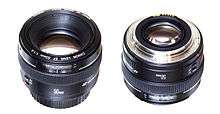
Canon 50mm lenses have an EF type mount that fits the Canon EOS line of cameras. When pairing a 50mm lens to a Canon DSLR with an APS-C sized sensor, the crop factor effectively turns the 50mm focal length into an 80mm field of view.
Seven EF 50mm lenses have been sold by Canon:
EF 50mm f/1.0L USM
The discontinued EF 50mm f/1.0L USM is a professional L series autofocus lens. On the used market sells for as much as double the original retail value. It was the fastest SLR lens in production during its lifetime.[4] This lens has a metal body and mount, and plastic extremities. It also features a wide rubber focus ring that is damped, a distance window with infrared index, and the ability to set the focus range from 0.6m to infinity, or 1m to infinity. In common with the EF 85mm f/1.2L USM it uses an electronic "focus by wire" system and requires power from the camera in order to manual focus. The 8-blade diaphragm and maximum aperture of f/1.0 give this lens the ability to create extremely shallow depth of field effects and to support low light situations. The optical construction of this lens contains 11 lens elements, including two ground and polished aspherical lens elements. This lens uses a floating front extension focusing system, powered by a ring-type USM motor. The front of the lens does not rotate, but does extend when focusing.
Despite its price and large maximum aperture, the 1.0L was not a particularly sharp lens at any aperture, and the two cheaper 50mm options offered far better sharpness when stopped down beyond about f/2.8.[9] This, combined with the high production cost and low sales volume, led to it being discontinued in 2000 and eventually superseded by the f/1.2 edition.
EF 50mm f/1.2L USM
The EF 50mm f/1.2L USM is a professional L series lens designed to replace the EF 50mm f/1.0L USM. It is constructed with a metal body and mount, and plastic extremities. This lens features a wide rubber focusing ring that is damped, a distance window with infrared index, and is fully weather-sealed, when a filter is added to the front. A circular, 8-blade diaphragm and maximum aperture of f/1.2 give this lens the ability to create very shallow depth of field effects with smooth background blur. The optical construction of this lens contains 8 lens elements, including one ground and polished aspherical lens element. This lens uses a floating front extension focusing system, powered by a ring-type USM motor. The front of the lens does not rotate or extend when focusing.
EF 50mm f/1.4 USM
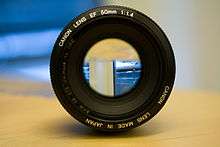
The EF 50mm f/1.4 USM is a consumer- and professional-level lens. It is the least expensive f/1.4 aperture lens that Canon currently manufactures. It is constructed with a plastic body and a metal mount. This lens features a distance window with infrared index. An 8-blade diaphragm and maximum aperture of f/1.4 give this lens the ability to create shallow depth of field effects. The optical construction of this lens contains 7 lens elements including 2 high refraction elements, but no aspherical, high dispersion or calcium fluoride elements. The lens uses a front extension focusing system, powered by a micro USM motor. Even though this lens uses a micro USM motor, it still has FTM (full-time manual focus) available. Auto-focus speed of this lens is fast, but not as quick as most ring-USM-based lenses. The front of the lens does not rotate, but extends by up to about one centimeter when focusing.
While similar to ring-USM lenses in terms of operation, the micro-USM motor is very prone to damage from impacts. Owners of the lens are encouraged to store the lens with the barrel fully retreated into the housing (that is, set to focus at infinity) to avoid damaging the AF motor during storage or transport. For a similar reason, use of a lens hood is recommended when the lens is mounted on a camera.
EF 50mm f/1.8
The EF 50mm f/1.8 is an economy level lens (discontinued in 1990), which has been replaced by the EF 50mm f/1.8 II. The body is plastic while the lens mount is stainless steel, and it features a distance window with infrared index. A 5 blade maximum aperture of f/1.8 gives this lens the ability to create depth of field effects. Note that this housing and use of a 5-blade aperture were shared with the EF 28mm f/2.8 and EF 35mm f/2 lenses, in the case of the latter to speed date of release and keep production costs low.
The optical construction of this lens contains 6 lens elements, with no special elements. This lens uses a front extension focusing system, powered by an AFD motor. The front of the lens does not rotate when focusing, making it compatible with circular polarisers.
Although auto-focus speed, despite the AFD motor, is moderately fast but audible, the lens is still very popular.
Because of its low price (it is sold used only) and very sharp optical quality, this lens has earned the preference of a lot of photographers. Obviously, when shooting at f/1.8, it offers a very shallow depth of field which is beneficial for isolating subjects against a blurred background (bokeh).
EF 50mm f/1.8 II

The EF 50mm f/1.8 II replaced the EF 50mm f/1.8 in 1991, until it was replaced by the STM version in 2015.
The EF 50mm f/1.8 II lens has a plastic lens mount, as opposed to the metal one on the original EF 50mm f/1.8. The manual focusing ring from the original was replaced by a very small thin focusing ring on the front tip of the lens, and the distance scale and the IR focusing label were removed. However the lens does not suffer from rotating front lens element and can be used with polarizing filters. The optics for both lenses are identical, with 6 elements in 5 groups and a 5 blade diaphragm, and both lenses have a 52mm filter thread.
Because of its low price and sharp optical quality, this lens earned the nicknames 'nifty fifty' and 'plastic fantastic'. When shooting at f/1.8, it offers a very shallow depth of field which is beneficial for isolating subjects against a blurred background (bokeh).
EF 50mm f/1.8 STM
Canon introduced the EF 50mm f/1.8 STM on May 10, 2015. This lens utilizes Canon's STM (STepper Motor) focusing mechanism, which supports the Movie Servo autofocus mode. The lens features a metal mount and has a rounded seven-blade aperture. Its filter diameter of 49mm is the smallest among all lenses in the family.[10]
EF 50mm f/2.5 Compact Macro

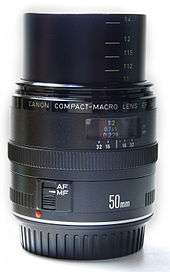
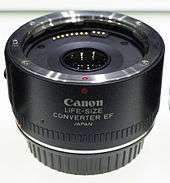
The EF 50mm f/2.5 Compact Macro is a relatively inexpensive macro lens with a minimum focusing distance of 23cm (9 inches) offering a maximum magnification of 0.5x actual size.[8] Reviewers describe the lens as having "decent"/"mid-level" build quality, with very good color and contrast, "absolutely negligible" distortion, very sharp after f/4 and peak performance at f/5.6. However, auto-focusing is relatively slow and noisy.[11][12]
The maximum 0.5x magnification means this lens is more suitable for photographing documents, products and objects at least 5cm (2 inches) wide than small insects etc. The outer barrel is grooved to accept Canon's MR-14 ring flash which can be used as the principal light source for close-ups or as on-axis fill lighting for portraits. The six-blade diaphragm provides reasonably good out-of-focus blur (bokeh) for portrait work.
First introduced in 1987, it is the oldest lens in Canon's current lineup (as of January 2014) that is still available new.[13] The lens is constructed with a plastic body and metal mount, and features a distance window with infrared index and magnification markings. The optional Life-Size Converter EF[14] adapts the lens to produce a maximum magnification of 1:1. Attaching the converter increases the lens focal length to 70mm, reduces the maximum aperture to f/3.5 and limits the focal range. Magnification markings for the converter are shown on the (extending) inner lens barrel.
Specifications
| Attribute | f/1.0L USM | f/1.2L USM | f/1.4 USM |
|---|---|---|---|
| Image | 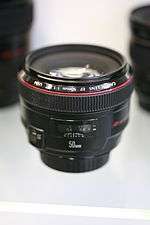 |
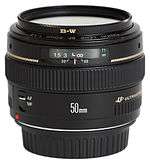 | |
| Key features | |||
| Full-frame compatible | |||
| Image stabilizer | |||
| Ultrasonic Motor | |||
| Stepping Motor | |||
| L-series | |||
| Diffractive Optics | |||
| Macro | |||
| Technical data | |||
| Aperture (max-min) | f/1.0-f/16 | f/1.2-f/16 | f/1.4-f/22 |
| Construction | 9 groups / 11 elements | 6 groups / 8 elements | 6 groups / 7 elements |
| # of diaphragm blades | 8 | ||
| Closest focusing distance | 2ft / 0.6m | 1.5ft / 0.45m | |
| Max. magnification | 0.11x | 0.15x (1:6.6) | |
| Horizontal viewing angle | 40° | ||
| Diagonal viewing angle | 46° | ||
| Vertical viewing angle | 27° | ||
| Physical data | |||
| Weight | 2.2 lb / 985 g | 1.2 lb / 545 g | 0.6 lb / 290 g |
| Maximum diameter | 3.6 in / 91.5 mm | 3.6 in / 85.8 mm | 2.9 in / 73.8 mm |
| Length | 3.2 in / 81.5 mm | 2.6 in / 65.5 mm | 2.0 in / 50.5 mm |
| Filter diameter | 72 mm | 58 mm | |
| Accessories | |||
| Lens hood | ES-79II | ES-78 | ES-71II |
| Previous case | - | ES-C9 | |
| Case | LP1216 | LP1214 | LP1014 |
| Retail information | |||
| Release date | September 1989 | January 2007 | June 1993 |
| Currently in production? | |||
| MSRP $ | $4210 | $1599 | $520 |
| Attribute | f/1.8 | f/1.8 II | f/1.8 STM | f/2.5 Compact Macro | |||
|---|---|---|---|---|---|---|---|
| Image | 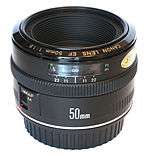 |
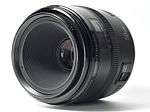 | |||||
| Key features | |||||||
| Full-frame compatible | |||||||
| Image stabilizer | |||||||
| Ultrasonic Motor | |||||||
| Stepping Motor | |||||||
| L-series | |||||||
| Diffractive Optics | |||||||
| Macro | |||||||
| Technical data | |||||||
| Aperture (max-min) | f/1.8-f/22 | f/2.5-f/32 | |||||
| Construction | 5 groups / 6 elements | 8 groups / 9 elements | |||||
| # of diaphragm blades | 5 | 7 | 6 | ||||
| Closest focusing distance | 1.5ft / 0.45m | 1.15ft / 0.35m | 0.749ft / 0.228m | ||||
| Max. magnification | 0.15x (1:6.6) | 0.21x (1:4.8) | 0.50x (1:2) | ||||
| Horizontal viewing angle | 40° | ||||||
| Diagonal viewing angle | 46° | ||||||
| Vertical viewing angle | 27° | ||||||
| Physical data | |||||||
| Weight | 0.4 lb / 190 g | 0.3 lb / 130 g | 0.3 lb / 159 g | 0.6 lb / 280 g | |||
| Maximum diameter | 2.6 in / 67.4 mm | 2.6 in / 68.2 mm | 2.7 in / 69.2 mm | 2.7 in / 67.6 mm | |||
| Length | 1.7 in / 42.5 mm | 1.6 in / 41 mm | 1.5 in / 39.3 mm | 2.5 in / 63 mm | |||
| Filter diameter | 52 mm | 49 mm | 52 mm | ||||
| Accessories | |||||||
| Lens hood | ES-65 or ES-65 III | ES-62AD | ES-68 | n/a | |||
| Previous case | ES-C9 | - | ES-C9 | ||||
| Case | LP1014 | LP814 | |||||
| Retail information | |||||||
| Release date | March 1987 | December 1990 | May 2015 | December 1987 | |||
| Currently in production? | |||||||
| MSRP $ | $130 | $125 | $299 | ||||
References
- Canon Inc. "EF50mm f/1.8 II". Canon Camera Museum. Retrieved 2017-05-12.
- "EF Lenses". Canon Camera Museum. Canon, Inc. Retrieved 2017-05-12.
- 50mm and the Human Eye, Gary Voth. Retrieved 2011-01-10.
- Canon Inc. "EF50mm f/1.0L USM". Canon Camera Museum. Retrieved 2017-05-12.
- Canon Inc. "EF50mm f/1.2L USM". Canon Camera Museum. Retrieved 2017-05-12.
- Canon Inc. "EF50mm f/1.4 USM". Canon Camera Museum. Retrieved 2017-05-12.
- Canon Inc. "EF50mm f/1.8". Canon Camera Museum. Retrieved 2017-05-12.
- Canon Inc. "EF50mm f/2.5 Compact Macro". Canon Camera Museum. Retrieved 2017-05-12.
- "Review of the Canon EF 50mm f/1.0L USM Lens, EF 50mm f/1.4 USM lens, and EF 50mm f/1.8 II Lens". wlcastleman.com.
- "Canon U.S.A. Introduces New EF 50MM F/1.8 STM Lens". 11 May 2015.
- "Canon EF 50mm f/2.5 macro - Review / Test Report - Analysis". Photozone. Retrieved 2010-06-18.
- Carnathan, Bryan. "Canon EF 50mm f/2.5 Macro Lens Review". The-Digital-Picture.com. Retrieved 2010-06-18.
- Carnathan, Bryan (January 9, 2014). "What are the 10 Oldest Canon Lenses Currently Available?". The-Digital-Picture.com. Retrieved January 10, 2014.
- Canon Inc. "Life-Size Converter EF". Canon USA. Retrieved 2007-10-15.
External links
| Wikimedia Commons has media related to |
50mm f/1.0L USM
50mm f/1.2L USM
50mm f/1.4 USM
50mm f/1.8 I & II
- JH Photography review
- DPreview
- photozone.de
- Comparison between Mark I & II
- SLRgear.com
- The-Digital-Picture (includes comparison of 50mm lenses)
- photo.net